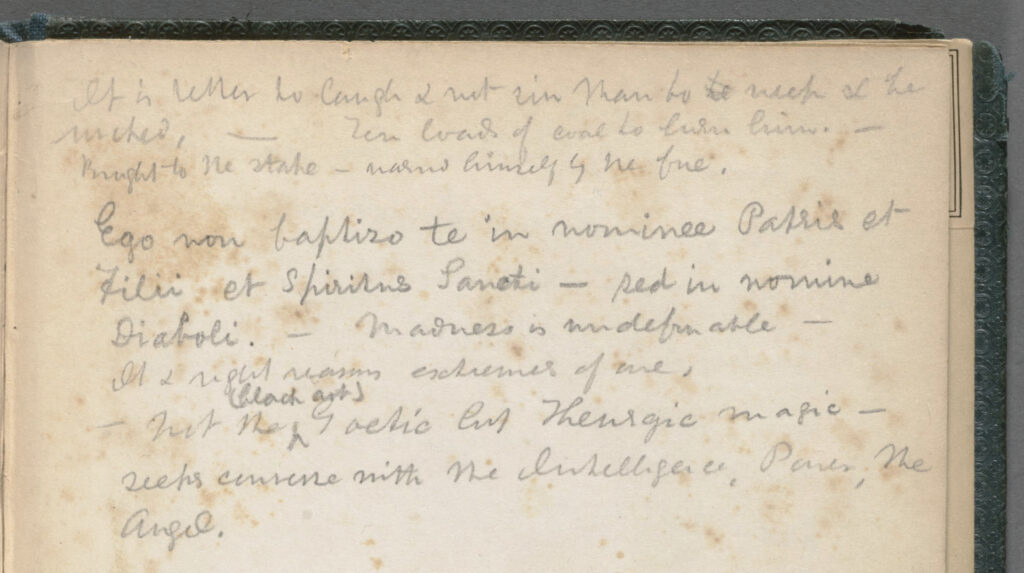Fashioned at last into an arrowy shape, and welded by Perth to the shank, the steel soon pointed the end of the iron: and as the blacksmith was about giving the barbs their final heat, prior to tempering them, he cried to Ahab to place the water-cask near.
Melville, Moby-Dick, Chap. 113: The Forge
»No, no–no water for that; I want it of the true death-temper. Ahoy, there! Tashtego, Queequeg, Daggoo! What say ye, pagans! Will ye give me as much blood as will cover this barb?« holding it high up. A cluster of dark nods replied. Yes. Three punctures were made in the heathen flesh, and the White Whale’s barbs were then tempered.
»Ego non baptizo te in nomine patris, sed in nomine diaboli!« deliriously howled Ahab, as the malignant iron scorchingly devoured the baptismal blood.
Ahab lässt sich eine neue Harpune schmieden, das Blut der drei ungetauften Harpuniere stählt die Waffe für den bevorstehenden Endkampf (und beinahe en passant entsteht hierdurch, da mit dem langsameren Abkühlungsprozess und den Salzen im Blut bessere Legierungseffekte erzielt werden, eine metallurgisch optimierte neue Harpune, die sowohl hinsichtlich Steifigkeit als auch Elastizität perfekt erscheint). Dass Ahab sein Eisen mit den Worten »Ego non baptizo te in nomine patris, sed in nomine diaboli!« – einer blasphemischen Formel – tauft, was er in einem Brief an Hawthorne als die geheime Formel seines Romans ausweist (s.u.), hat u.a. zur Vorgeschichte, dass Melville dies erstmals auf den hinteren Vakatseite des siebenten von sieben Bänden seiner Shakespeare-Dramenausgabe (die König Lear, Romeo und Julia, Hamlet und Othello beinhaltet) – Shakespeare, William: The Dramatic Works of William Shakespeare. Boston: Hilliard, Gray 1837, Vol. VII – notiert:
It is better to laugh & not sin than to weep & be [/] wicked. — Ten loads of coal to burn him. — [/] Brought to the stake — warmed himself by the fire.
Melville
Ego non baptizo te in nominee Patris et [/] Filii et Spiritus Sancti — sed in nomine [/] Diaboli. — Madness is undefinable — [/] It & right reasons extremes of one. [/] — Not the (black art) Goetic but Theurgic magic — [/] seeks converse with the Intelligence, Power, the [/] Angel.

Aber es ist doch nur die gleichsam Shakespearsche Schreibfläche, in die das notiert wird, nicht jedoch sind Shakespeares Dramen der Anlass.
Am 29. Juni 1851 schreibt Melville an Hawthorne:
Shall I send you a fin of the Whale by way of a specimen mouthful? The tail is not yet cooked—though the hell-fire in which the whole book is broiled might not unreasonably have cooked it all ere this. This is the book’s motto (the secret one),—Ego non baptiso te in nomine—but make out the rest yourself.
Bis auf »It is better to laugh & not sin than to weep & be [/] wicked.« der ob genannten Annotation in dem Shakespeare-Band stammt alles andere wesentlich (und das wird auch für einen Hawthorne-Text Bedeutung haben; Anm.) aus Francis Palgraves »Superstition and Knowledge« (Quaterly Review v. Juli 1823), der seinen Essay über Hexen, Hexenjagd und Aberglauben wesentlich entlang zweier Bücher hochzieht: A Collection of rare and curious Tracts on Witchcraft, and the Second Sight, or an original Essay on Witchcraft sowie The famous History of Friar Bacon, containing the wonderful Things that he did in his Life, also the Manner of his Death; with the Lives and Deaths of the two Conjurers, Bungay and Vandermast.
Die Stelle mit der Kohle? Eine ›Hexenverbrennung‹ in Schottland. Und die in den MD übernommene lateinische Passage – die im Wortlaut also keine Erfindung Melvilles, sondern sein Exzerpt darstellt – hat mit einer Begebenheit am Bischofssitz zu Bamberg, im 17. Jahrhundert, zu tun: 600 Frauen (so die Annahme Palgraves und Melville, tatsächlich wurden im Zuge einschlägiger Anklagen zwischen ca. 1612 und 1632 wohl um die 1.000 Frauen, Männer, Kinder umgebracht) wurden von ihren ›Hexenjägern‹ möglichst grausam ermordet, die katholischen Priester hatten ein entsprechendes Tauf-Reframing vorzunehmen. Von diesem Wahnsinn schreibt Palgrave, liest Melville; dies schreibt er wiederum Ahab mit ein. Palgrave notierte: »Madness is almost undefinable. Right reason and insanity are merely the extreme terms of a series of mental action, which need not be very long.«
Danach geht es im Melvilleschen Notat im Shakespearschen Band (auch dies aus der ersten Hälfte von Palgraves Essay entnommen) um die Frage der Magie im mittelalterlichen Spanien, in Toledo, Salamanca und Simanca.
Vgl. dazu u.a.
• Geoffrey Sanborn: The Name of the Devil: Melville’s Other »Extracts« for Moby-Dick. In: Nineteenth-Century Literature 47.2 (September 1992), S. 212-35.
• Niels Werber: Kapitel 113: The Forge. Bluttaufe und Schmiedekunst. Eine Harpune für Ahab. In: Neue Rundschau 1/2017, S. 160–172.


